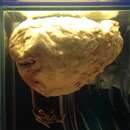en
names in breadcrumbs


View data on Catalog of Fishes here.
Metamorphosed females of the H. appeli differ from those of other species of the genus in having a series of 2–7 filaments emerging from the anterior margin of the two primary branches of the paired posterior escal appendage. They differ further in having the following combination of character states: The distal light-guiding escal appendage is divided at the base, its total length (1.3–5.0% SL) less than the diameter of the escal bulb in most specimens, but longer (10 to about 20% SL) in some of the largest known specimens (192–300 mm). Each primary branch of the distal escal appendage bears 1–3 small side branches (usually a pair). The distal escal swellings are not distinctly divided into lobes. The anterior escal appendage is absent. The posterior escal appendage is divided at the base, its length 10% to about 45% SL in specimens greater than 30 mm. The base of escal bulb bears 0–5 posterolateral appendages in smaller specimens, but as many as 18 in some larger specimens. The distal-most pair of posterolateral appendages emerges less than one-half the diameter of the escal bulb below the base of the posterior escal appendage. The posterolateral appendages are simple or bifurcated at the tip; the longest is less than 10% SL in specimens less than 100 mm. There are small dermal spinules present on the stem of the illicium, the escal bulb, and escal appendages in specimens greater than 30 mm. The papillae of the snout and chin are low and indistinct. The skin is devoid of “white patches.” The caudal-fin rays are white or only faintly pigmented in specimens less than about 100 mm.
Adult males have 11–13 olfactory lamellae. The diameter of the posterior nostril is 5.7–6.7% SL, the length of the snout 17–18% SL. There are 20 to about 25 upper denticular teeth and 22–32 lower denticular teeth. The larvae most probably lack a dorsal pigment spot.
All records of Himantolophus appelii are from southern parts of the Atlantic, Indian, and Western Pacific oceans between 27° and 43°S.
Meso- and bathypelagic, larger specimens bathydemersal.
Pietsch TW. 2009. Oceanic Anglerfishes: Extraordinary Diversity in the Deep Sea. Berkley: University of California Press. 638 p.
Bertelsen E, Krefft G. 1988. The ceratioid family Himantolophidae (Pisces, Lophiiformes). Steenstrupia 14(2):9–89.
Maul GE. 1961. The ceratioid fishes in the collection of the Museu Municipal do Funchal (Melanocetidae, Himantolophidae, Oneirodidae, Linophrynidae). Bol Mus Mun Funchal 14(50):87–159.
Except for the presence of white circular scars found on the bodies of five females, which Maul (1961:115, fig. 15) argued might be “the result of an injury caused by a male that had grown fast there and has for some reason become suddenly detached”—but which Bertelsen and Krefft (1988) suggested might be caused by parasitic copepods—there is no evidence of sexual parasitism in this family.
Known from 115 metamorphosed females at 14 to 320 mm SL.
Off Westland, New Zealand, about 43°S, 170°E, stranded, not preserved.
Holotype of Aegoeonichthys appelii: 287 mm.
The prickly anglerfish (Himantolophus appelii) is a footballfish of the family Himantolophidae, found around the world in the southern oceans (apart from eastern Pacific), in deep water. Its length is up to 40 cm (16 in). It is a mesopelagic species.
A specimen was collected on November 14, 2007. It was a female that was collected east of the Falkland Islands at a depth of 292–318 m (958–1,043 ft). The specimen measured 21 cm (8.3 in) in total length and weighed 616 g (21.7 oz).[1]
It was first described in 1878 by Frank Edward Clarke as Aegoeonichthys appelii.[2][3] The species epithet honours Mr Appel who provided F. E. Clarke with a specimen.[3]
The prickly anglerfish (Himantolophus appelii) is a footballfish of the family Himantolophidae, found around the world in the southern oceans (apart from eastern Pacific), in deep water. Its length is up to 40 cm (16 in). It is a mesopelagic species.
A specimen was collected on November 14, 2007. It was a female that was collected east of the Falkland Islands at a depth of 292–318 m (958–1,043 ft). The specimen measured 21 cm (8.3 in) in total length and weighed 616 g (21.7 oz).
It was first described in 1878 by Frank Edward Clarke as Aegoeonichthys appelii. The species epithet honours Mr Appel who provided F. E. Clarke with a specimen.